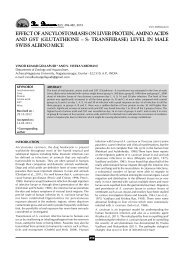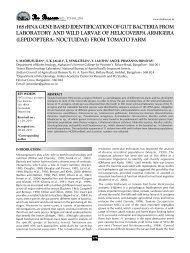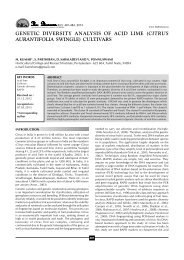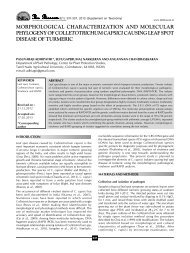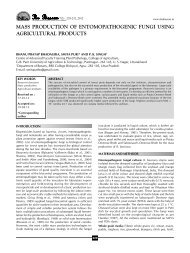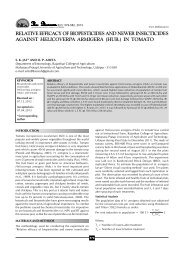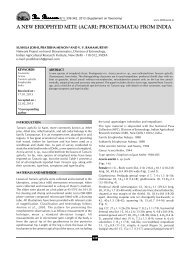full paper - THE BIOSCAN
full paper - THE BIOSCAN
full paper - THE BIOSCAN
Create successful ePaper yourself
Turn your PDF publications into a flip-book with our unique Google optimized e-Paper software.
U. K. SAHOO et al.,<br />
community (i.e. 300). The dominance index (Simpson, 1949) of the community was calculated as: C=” {(n i<br />
/<br />
N) 2 }, where C=dominance index, n i<br />
and N are same as for Shannon’s index. Pielou’s (1966) evenness index<br />
(e) was calculated as: e= H’/logS, where H’= Shannon’s index of diversity, and S= Total number of<br />
species. Sorenson’s similarity index (Sorenson, 1948) was calculated as, [2C/(A+B)] x 100], where, A and<br />
B are the total species content (trees, shrubs or herbs) in stand A and B respectively, while C is the number<br />
of species common to both stands.<br />
Soil analysis<br />
Five cores (6.5 cm inner dia) from 0-15 cm and 15-30 cm depth were collected from each selected homegarden<br />
in the month of March. All the soils collected were pooled garden-wise and depth-wise and sieved through<br />
2mm mesh screen. The soil moisture content (SMC), pH, ammonium-N and nitrate-N were determined<br />
within 36 hours of sampling following standard procedures given in Anderson and Ingram (1993). Rest of the<br />
soil samples were air-dried and analyzed for total kjeldahl nitrogen (TKN) using Kel Plus (Pelican model),<br />
while available phosphorous and soil organic carbon (SOC) was estimated by molybdenum blue method and<br />
rapid titration method respectively as given in Allen et al. (1974). Water holding capacity (WHC) was<br />
determined using Keen’s box and the SOC values were multiplied by a constant (1.724) to obtain the soil<br />
organic matter (SOM) values (Allen et al., 1974). Soil texture was determined by Boucous hydrometer<br />
method (Anderson and Ingram, 1993).<br />
Microclimatic variables<br />
The microclimate in the home gardens were studied by measuring light intensity, relative humidity and air<br />
and soil temperatures. The light intensity was measured using a digital lux meter. The air temperature and<br />
relative humidity were measured using a thermo-hygrometer. Soil temperature was measured using a soil<br />
thermometer.<br />
Energy input/output<br />
A process analysis was used to measure energy flow (Fluck, 1992) adding human work contributions (Odum,<br />
1996). Internal and external inputs were measured in Mega Joules (MJ). These were estimated by extrapolating<br />
standard energy values (Mitchell, 1979; Mittal and Dhavan, 1989 and Gopalan et al., 1982). The input of<br />
energy through seeds was calculated on the basis of total energy expended to produce that fraction of the<br />
crop yield. The economic yield per hectare in all cases was calculated on the basis of the entire plot. For<br />
calculating the output of energy the total economic yield of various crops was converted into mega joules of<br />
energy by multiplying with similar standard values. The energy efficiency of each system was calculated as<br />
the output/input ratio.<br />
Input of household labour is a component that needs to be factored to an economic valuation. For the purpose<br />
of this study, opportunity cost of household labour is calculated as a function of time, OC HL<br />
=ƒ (t * labour<br />
rate), where t is the time spent in the garden. The opportunity costs of land have been assigned values<br />
equivalent to the rate at which farmers were able to lease out all or parts of their lands. This rent was<br />
calculated to be an average of Rs. 9500 per hectare of the land per year. For monetary input/output analysis,<br />
labour charge was calculated on the basis of prevailing daily rates of Rs 70. The monetary returns in terms<br />
of crops, feed, milk, egg and organic manure were calculated based on prevailing market price for each<br />
commodity.<br />
RESULTS AND DISCUSSION<br />
Garden size, vegetation composition and dynamics<br />
The size ranged from 144 m 2 to 0.9 ha with a mean of 0.3 ha area. The average homegarden size in small<br />
category was 1152 m 2 , 3895 m 2 in medium and 8500 m 2 in large gardens in the three different villages. The<br />
altitudinal range varies from 56 m asl to 960 m asl. The location of the homegarden in the three villages<br />
ranged from 23º48´58.2½ N to 23º54´53.5½ N latitude and 92º29´41.9½ E 92º25´27.4½ E longitude.<br />
162



